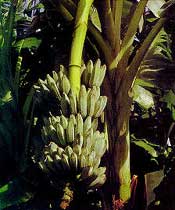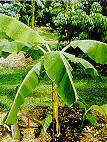By Priti Sawant
English name: Plantain; Hindi name:
Kela; Scientific name: Musa paradisiaca

To Indians this tree is synonymous with plenitude. It is frequently planted in backyard so that its fruit, combs of bananas, can be offered to the gods in gratitude for the fertility with which they have blessed the earth.
In many parts of India the plantain is regarded as a reincarnation of the goddess of plenty herself, and whole living trees are made an integral part of the marriage ceremony. Their tapering trunks generous leaves ceremoniously flank the entrance
to the marriage arena. The posts and the canopy of the wedding pavilion are made from its branches and leaves.
A popular story of Mahabharata is that: Before the outbreak of war between the Kauravas and Pandavas, Krishna went as a mediator. The Pandavas did not want war but their cousins; the Kauravas were adamant o it and would not listen to Krishna’s
advice even after he had predicted the destruction of the entire race. Defeated in his mission, Krishna visited Vidura, a half brother to both Pandu and Dhritrashtra. Vidura was not at home. Viduri, his wife offered Krishna the Banana fruit. She was so enraptured
by Krishna having come to her house that absent-mindedly; she threw away the fruit and offered only the peels of the fruit to Krishna. Krishna noticed it but kept on eating the peels as they were offered to him with a pure heart and with unflinching devotion.
Gadaba tribe of Orissa believes that Plantain plant bears fruit without pollination and fertilization of its flowers because of the following reason. Long ago, there were five sisters called Mango, Tamarind, Fig, Jamun and Plantain. When the
sisters grew in their teens, their father was worried about finding them suitable husbands. To ascertain their wishes, he called them one day. Except for the plantain, other four sisters wanted husbands and many children. When plantain was asked what she desired,
she replied that she wanted children but not a husband. And also that she wanted to get old soon without having to wait for long time.
 In course of time, Mango, Tamarind, Fig and Jamun got married and bore so many children that their husband ran away in sheer fright. These girls in the next life were born as trees and bore many fruits that symbolically are the children
they had in their previous life. Plantain did not marry but produced children and grew old. Plantain plant bears fruit parthenogenetcally, that is without fertilization and the fruits do not have seeds.
In course of time, Mango, Tamarind, Fig and Jamun got married and bore so many children that their husband ran away in sheer fright. These girls in the next life were born as trees and bore many fruits that symbolically are the children
they had in their previous life. Plantain did not marry but produced children and grew old. Plantain plant bears fruit parthenogenetcally, that is without fertilization and the fruits do not have seeds.
The plantain is also famed for its medical uses. Taken orally, fresh plantain sap is a purgative. When applied locally, it is a styptic. Its leaves are easily disinfected; hence they are used as poultices
for open wounds. The dense textured flowers are eaten as delicacy, but when raw they are powdered into a medicine for gynecological ailments. The green fruit is valued for its astringent and cooling properties. The ripe banana, universally known to be rich
in minerals and vitamins, is often pulped and given to convalescing patients because it is easily digestible, soothing the mucous membranes and providing a nutrient for hemoglobin.